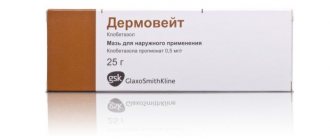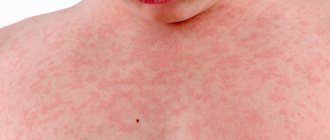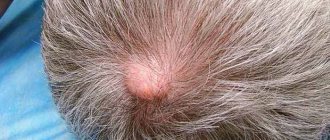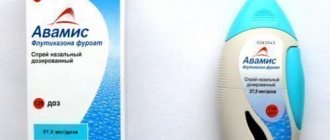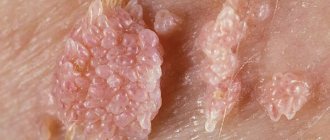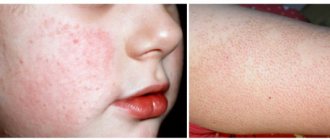Last update: 01/14/2020
A type of chronic eczematous dermatitis, accompanied by symptoms of dyshidrosis (dehydration) of the skin, is called dyshidrotic eczema. The disease most often affects the hands and feet and occurs in both adults and children. Its manifestations are in many ways similar to other types of dermatitis, as well as fungal skin infections.
Causes
The exact mechanism of occurrence of this disease is not yet known. Until recently, it was believed that the main reason for its development was a malfunction of the sweat glands, but recent studies show that the occurrence of didyshidrotic eczema is possible even with their normal functioning. Among the factors that provoke the onset of symptoms of the disease are the following:
- nervous and physical stress
- contact with household chemicals and other substances that cause skin irritation
- hyperhidrosis - extremely intense sweating
- inherited predisposition to atopic dermatitis, bronchial asthma and other allergic diseases
- food and household allergens
Also of great importance are disturbances in the functioning of the immune and endocrine systems, nervous system, and metabolic disorders.
Symptoms of dyshidrotic eczema
The most characteristic manifestation of dyshidrotic eczema on the hands and other parts of the body is a vesicular rash - a rash consisting of many blisters with a diameter of up to 4-5 millimeters, filled with liquid contents. In this form of the disease, the blisters are located deep inside the epidermis and, as a result, cause severe itching. In some cases, it precedes the formation of bulk elements. The palms, backs of the hands, soles of the feet, and sides of the fingers are the most common sites for the rash.
Some time after the appearance, the vesicles burst, the contents flow out, and areas of ulceration appear at the site of the rash. When several bubbles are opened, erosions can combine. Gradually, the ulcers heal and become covered with yellowish or brown crusts. The process of formation of new rash elements, their opening and healing can last up to 3 weeks; after healing, an area of hyperpigmentation (darkening) remains at the site of erosion.
With a long course of the disease, a constant, chronic change in the structure and appearance of the skin occurs. The skin turns red and thickens, deep cracks form on it, and areas of peeling appear. Dyshidrotic eczema is also characterized by the formation of areas of dry, dehydrated skin, resembling wax paper in appearance.
The entry of pathogenic microorganisms (for example, streptococci) into cracks and ulcers causes secondary infection. At the same time, the symptoms also change: most often, pustules with purulent contents form on the surface of the skin, and purulent inflammation of the skin occurs. Soreness, swelling and redness occur, symptoms of general intoxication appear - headache, fever, in some cases - nausea, appetite and sleep disorders, enlarged lymph nodes (axillary, elbow, inguinal, popliteal).
Despite the fact that there are acute forms of the disease, most often didyshidrotic eczema occurs in a chronic form with relapses occurring from time to time. Remissions can last up to several months. Exacerbations do not always occur upon contact with allergens or irritating substances and can occur against the background of complete health.
How it manifests itself
In its development, the disease goes through several stages.
- There is a feeling of itching and tingling in some areas on the palms and fingers. The skin in these areas may become warmer, but there is no change in color.
- The itching intensifies, and small bubbles with clear liquid appear in the thickness of the skin. The size is usually smaller than the head of a pin.
- The bubbles may merge, the liquid in them becomes somewhat cloudy and yellowish. The palms and fingers are somewhat swollen.
- The opening of liquid formations occurs spontaneously or as a result of scratching. If there are a lot of burst bubbles, painful sensations appear.
- The skin of the palms peels off, separates into plates, and becomes rough.
At the stage of opening of the blisters, cracks form on the skin, which easily become infected, especially when scratching. As a result, depending on the strength of the immune system, local suppuration, phlegmon, and inflammation of the lymphatic vessels appear. In severe cases, the axillary lymph nodes are involved.
Dyshidrosis of the hands photo:
Diagnostics
Currently, there are no specific methods to accurately determine the disease. Its main signs are characteristic external manifestations; Dyshidrotic eczema is also indicated by the chronic nature of the disease. Among the diseases to exclude which differential diagnosis is carried out are contact dermatitis, fungal infections and palmoplantar psoriasis.
The main laboratory method of differential diagnosis is the examination of scrapings for the presence of pathogenic fungi. The contents of blisters and scrapings from areas of erosion are also used for research. This makes it possible to confirm the non-infectious origin of the disease, and in the presence of a secondary infection, to accurately select antibiotics to combat its causative agents.
Nutrition rules
Diet and the consumption of food products that are necessary for the restoration and normal functioning of the body are also important.
Prohibited intake: flour products, bread, chocolates; fast foods, fried foods, smoked products and pickles; any fatty foods, including fatty fish and meat; sauces, ketchup, mayonnaise, hot spices, horseradish, mustard, salt; all sour fruits - oranges, lemons, pomegranates, grapefruits, kiwis, apples;
The consumption of alcoholic and carbonated drinks is also prohibited; onions, garlic; tomatoes; potatoes; dairy products; melons and watermelons. It is preferable to use mostly natural products, not fried, but stewed, boiled, baked or steamed. You can cook dishes in a slow cooker.
Protein foods allowed include turkey meat and chicken breast, beef and quail. River fish will benefit a person who develops dyshidrotic eczema on the hands.
It is possible to diversify the diet with vegetable stews, liquid porridges, vegetable and fruit salads, and light broth soups. Do not neglect any of the listed points for the treatment of dyshidrotic eczema of the hands.
Only in the aggregate and by following all the doctor’s recommendations will it be possible to minimize unpleasant symptoms and prevent the development of a chronic form of the disease.
Source: tvoidermatolog.ru
Prevention and treatment of dyshidrotic eczema
When the first symptoms of the disease appear, you should immediately contact a dermatologist. Primary measures to combat eczema include following a hypoallergenic diet, from which the following components should be excluded:
- citrus
- chocolate
- nuts
- honey
- strawberry
- fish and other seafood
Of great importance is the elimination of contact with substances that irritate the skin - household chemicals, pollen,
wool, dust and other allergens. Tight shoes and synthetic socks for dyshidrotic foot eczema can also influence the development of the disease.
During the active period of the disease, which is accompanied by increased skin sensitivity and severe itching, lotions with 1% tannin solution, 2% boric acid solution, 0.25% silver nitrate solution, baths with 0.01-0.1% potassium permanganate solution are used, cindol solution 1-2 times a day for 4-7 days. The duration of local baths is from 15 to 25 minutes.
Drug therapy includes the use of the following:
- antihistamines and sedatives to relieve itching and swelling - Tavegil, Zyrtec, Suprastin
- ointments and other preparations based on corticosteroids - in severe cases of the disease to eliminate external symptoms; Long-term use of corticosteroids is not recommended due to the high risk of dependence and complications
- antiseptics - disinfectant solutions eliminate the risk of secondary infection
- antibiotics - used to prevent and treat fungal and bacterial infections in the form of ointments, tablets or injections
Some physiotherapeutic methods also have a beneficial effect on dyshidrotic eczema: laser, magnetic, cryotherapy, ultraphonophoresis, darsonvalization, ultraviolet irradiation, electrosleep, acupuncture.
ethnoscience
To relieve constant itching that leads to scratching, starch ointments or mash are often used in therapy.
A tablespoon of starch is mixed with 2 tablespoons of water and the composition is applied to the affected area of skin throughout the day. To make an ointment, starch is ground with regular petroleum jelly in a ratio of 1 to 2. Compresses with chopped cabbage leaves or raw potato pulp relieve itching, soften the skin, and moisturize it. Sea buckthorn oil actively restores the skin. Egg white mixed with a spoonful of glycerin moisturizes hands. You can add a few drops of alcohol lotion to disinfect the wound.
Yarrow decoction is taken orally to reduce skin vulnerability. Pour 20 g of millennial herb into a glass of boiling water, leave for an hour and take 2 tablespoons before meals.
Hand baths with chamomile infusion and oak bark infusion have a disinfecting and calming effect. Some patients benefit from black oil hand baths. All products using petroleum products should be used with caution.
Irradiation with a quartz device such as “Sun” or “Fairy” will help relieve inflammation, dry wounds and disinfect them. A blue lamp has the same effect. It is important not to overdo it so that the affected skin does not also receive a UV burn.
Traditional methods of treatment can have a positive effect on the condition of the skin, especially during the chronic course of the disease:
- Mix 2 tablespoons of white cabbage, chopped into a pulp, and the same amount of raw potato pulp. Apply to affected areas, leave under a bandage for 10-15 minutes. The product promotes the healing of eczema ulcers.
- Itchy blisters on the hands or feet can be lubricated with the following lotion: lemon juice, egg white, shake 1 spoon of glycerin, then pour in 100 ml. cologne. You can wipe the skin as the itching intensifies, but not more than 3 times a day.
- Infusions of yarrow, string, and chamomile are used to speed up the healing of scabs on the hands.
- Sea buckthorn oil can be applied to affected areas of the skin daily, which promotes rapid tissue regeneration.
- Pharmacy tincture of eucalyptus is diluted with water in a 1:1 ratio, after which a bandage is moistened and applied in the form of applications to the hands; exposure time – 5-10 minutes.
- It is recommended to take infusions of St. John's wort internally (1 spoon of the plant per glass of boiling water), calendula flowers (1 teaspoon per 200 ml of boiling water), sage leaves (2 spoons per 250 ml of water), as well as a decoction of willow bark (1 tablespoon of bark per 400 ml water). Such products are consumed in 50-70 ml. 3 times a day to increase the body's resistance, improve blood circulation, and accelerate skin healing.
- Juice from burdock leaves is used to wipe the affected area, as well as to take 1 spoon orally 2 times a day.
- After scabs form, you can lubricate the skin with 100 ml of ointment daily. tar, 4 egg yolks, 50 ml. cream.
A herbal tincture of sage in combination with a decoction of yarrow herbs treats the skin. For this medicine you need to take 10 g of herbs. Infuse sage in hot, but not boiling, water for 6 hours. And the string with yarrow is brewed with boiling water, leaving for 2 hours.
Massaging your hands in areas where there are no eczema blisters can be an excellent distraction for severe itching. Acupuncture, which is prescribed to patients with eczema to normalize the state of the nervous system, can be replaced at home with cupping massage.
Phytovannas with a series cleanse the skin. Pine baths have a beneficial effect (but only if the patient does not have allergies). Natural oils perfectly soften the skin and help it restore its natural protection.
2 tablespoons of grape seed oil are mixed with 10 drops of geranium essential oil, tea tree oil, 10 drops of chamomile infusion and lemon balm infusion. Instead of grape seed oil, you can use peach or apricot bone oil. These compositions dry weeping ulcers and cleanse the skin.
Wounds heal faster and do not form ulcers if you lubricate them with fresh celandine juice. It relieves inflammation and has a disinfectant effect.
A tincture of 4 teaspoons of horseradish (freshly ground or finely grated) with 500 ml of water refreshes the skin and relieves itching. Wipe the skin with the infusion.
Blackberry castings help get rid of inflammation. 100 gr. dry leaves are poured into 1.5 liters of water, boiled and left for half an hour, and then wiped on the skin.
Physiotherapeutic agents help a lot with eczema; at home they can be replaced with ice rubdowns. To harden and relieve itching, rub the affected skin with an ice cube 2-3 times a day.
This procedure is even more effective if, instead of ordinary water, you use a mineral or herbal decoction (chain, nettle, mint, etc.) to make ice.
Source: narodnimisredstvami.ru
La-Cri remedies for dyshidrotic eczema on the hands and feet
La-Cri cosmetics based on medicinal plant extracts are widely used to eliminate the symptoms of the disease. They do not cause allergies and can be used for daily care even for children's skin. The range includes cleansers that remove impurities and reduce the risk of infection, as well as emulsions and creams that nourish and strengthen dry and damaged skin, reduce redness and itching, and promote accelerated healing of damaged skin.
Consumer Reviews
viki2013 about La-Cree emulsion (otzovik.com)
“When my daughter was 3 months old, our neck turned red. It was dry, with a small rash. No matter what I tried, nothing saved us. I bought an emulsion at the pharmacy. Just a couple of days later the beauty began to subside. And gradually everything passed practically. She helped us with allergies, mosquito bites, and simply dry skin. Wonderful emulsion and pleasant composition.”
Accoly about La Cree cleansing gel (otzovik.com)
“We became acquainted with the Vertex gel after we assessed the effectiveness of the ointment from the same manufacturer. This company's products are sold in pharmacies. The gel is packed in a box. The tube contains only 200 mg.
As indicated on the label and the bottle itself, the products of this company can be used from birth. But whether a newborn child should be exposed to such agents from the first days of life, I doubt it. In the first year of life, it is enough to add a decoction of chamomile or string and bathe the baby in it. This will protect his skin from inflammation and help cope with heat rash, which is common in children. In addition, even the chlorine contained in city water is harmful to the baby; it is better to settle and boil the water, and what can we say about store-bought products...
The fact that these are the same manufacturer can be easily guessed by the characteristic smell, which for some reason reminds me of the smell of thyme, although it is not included in the composition. Although the gel is not large in volume, it lasted us more than half a year with constant use. As the manufacturer recommends, I used it as bath foam - 3.4 pumps is enough. It foams well, enough to make ice cream out of foam until the end of the bath...
...The composition of the gel is rich in useful additives. But in the first place, water and an emulsifier are sodium laureth sulfate, which, according to experts involved in testing the safety of cosmetic ingredients, can cause skin irritation at a concentration of 2%. It promotes foaming and has good cleaning properties. To mitigate its negative effects, the gel contains cocamidopropyl betaine and sodium cocoamphoacetate.
There is also a cocamide DEA thickener. Well, then olive oil, licorice and walnut extract, and avocado oil are already listed.
Then, glyceryl cocoate is a self-emulsifying substance. Next, citric acid, a not particularly harmless preservative, methylchloroisothiazolinone, but replacing parabens and the latter in the composition, rosewood oil.
During the entire time we used the gel, we did not have any rashes or irritations. I generally like the gel, but if I could create foam in the bath in an even more harmless way, I would refuse it. In general, I recommend it, but not from birth, but from the age of 3...”
Sources:
- Molochkova Yulia Vladimirovna, Dermatology. Brief reference book, publishing house: GEOTAR-Media, 2017
- Baumann Leslie, Cosmetic Dermatology. Principles and practice, publishing house: MEDpress-inform, 2016
- Ratner Desiri, Avram M.R., Avram M.M., Procedures in Dermatology. Clinical cosmetology, Publishing house: GEOTAR-Media, 2019
Photos of eczema
Photo album on the disease
